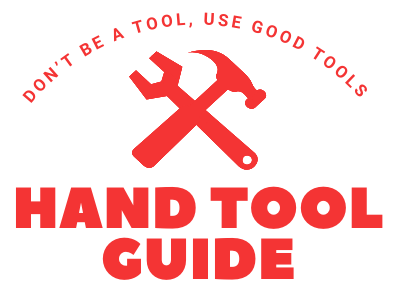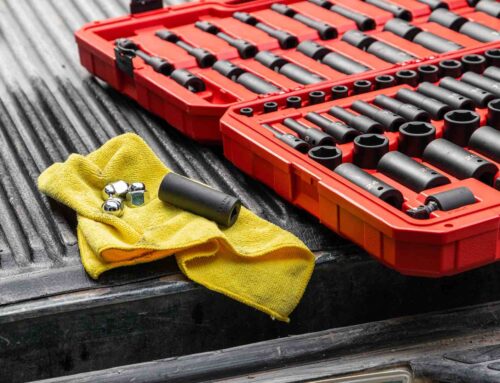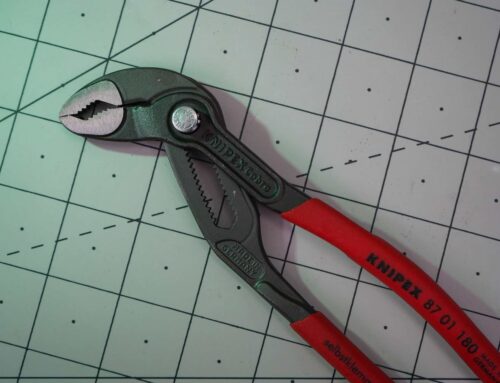
Looking for the Best Orbital Sander, Cordless and Corded?
Are you seeking the best orbital sander to make your sanding projects easier? Look no further! In this article, we’ll discuss our top picks for the best orbital sanders. We’ll cover five different sanders, their pros and cons, and why we believe they are the best. So, let’s get started and simplify your sanding process!
Understanding Random Orbital Sanders
Orbital sanders are essential tools for anyone who wants to achieve a smooth, professional finish on their woodworking projects. These versatile power tools use a circular sanding motion combined with a random orbital pattern to sand a wide range of surfaces efficiently. Understanding how orbital sanders work and their various features will help you choose the best sander for your needs.
At its core, an orbital sander consists of a circular sanding pad that moves in an elliptical pattern while spinning simultaneously. This dual-action movement ensures the sanding motion is random, preventing any visible sanding marks on the workpiece. The circular motion removes material efficiently, while the random orbital pattern minimizes the risk of creating swirl marks on the surface.
What Power Sander is Right for You?

What is the best orbital sander?
When choosing the best orbital sander for your project, there are a few factors to consider. The first is the size of the sanding pad. Most orbital sanders come with either a 5 or 6 inches sanding pad. The larger the pad, the more area you can cover in less time. However, larger sanding pads can be more challenging to control, especially on intricate or curved surfaces.
Another crucial factor is the speed and power of the sander. Orbital sanders typically offer variable speed options, allowing you to adjust the speed based on the material and the desired finish. Additionally, more powerful sanders can handle heavier sanding tasks and quickly remove material.
When Buying a Random Orbital Sander, do You Choose Cordless or Corded?
One consideration that separates orbital sanders is whether they are corded, cordless, or even air-powered. Electrical orbital sanders are more common and are typically more accessible to hobbyists and DIYers. They are also generally more affordable and more accessible to use, requiring only a standard electrical outlet.
On the other hand, air-powered orbital sanders, also known as pneumatic sanders, require an air compressor to function. While they may require additional equipment, they are often more robust and durable, making them the preferred choice for professional woodworkers.
With battery advancement today, lithium-ion cordless sanders are probably the best random orbital sanders of 2023 for DIYers. They get the job done with very little fuss. Cordless random orbital sanders are often more expensive. But these sanders offer better control and many advantages over a corded sander in most circumstances. The best cordless orbital sanders use brilliant battery tech that keeps the sander light and exceptionally easy to maneuver. This makes the job of sanding that little bit easier.
What other features make the best random orbital sander?

What features make the best random orbital sander?
Lastly, look for features that enhance user comfort and convenience, such as an ergonomic handle, dust collection system, easy-to-change sanding discs, and low vibration. These features can significantly improve the overall sanding experience and minimize fatigue during extended use.
Understanding orbital sanders is essential to choosing the best sander for your woodworking projects. Consider the size of the sanding pad, the speed and power options, the type of sander, and additional features when selecting. Investing in the best orbital sander for your needs, you can achieve professional-level results and simplify your sanding process. Sometimes, a belt sander is the best tool for the job.
Also, can you buy these at your local Home Depot, and are they reputable brand names with good service backup?
These are our top 5 best overall picks to keep your woodworking looking awesome:
Now that we understand orbital sanders let’s dive into our top picks for the best random orbit sanders on the market. We’ve done the research and narrowed our selection to five outstanding options that will meet your sanding needs. Whether you’re a DIY enthusiast or a professional woodworker, these orbital sanders will make your projects a breeze.
- Bosch ROS20VSC Random Orbital Sander, 2.5 Amp 5 In. Corded with Variable Speed

This electrical orbital sander is perfect for beginners, hobbyists, and even more serious projects. It offers a 5-inch sanding pad, providing a good balance between coverage and control. With variable speed options, you can easily adjust the sanding speed to achieve your desired finish.
This sander is also equipped with a very effective dust collection system. In fact, it probably had the best dust collection in this test. This system keeps your workspace clean and reduces airborne particles. Its ergonomic handle ensures comfortable and fatigue-free use, making it an excellent choice for long sanding sessions. It is also often sold with a nice carrying bag in the kit.
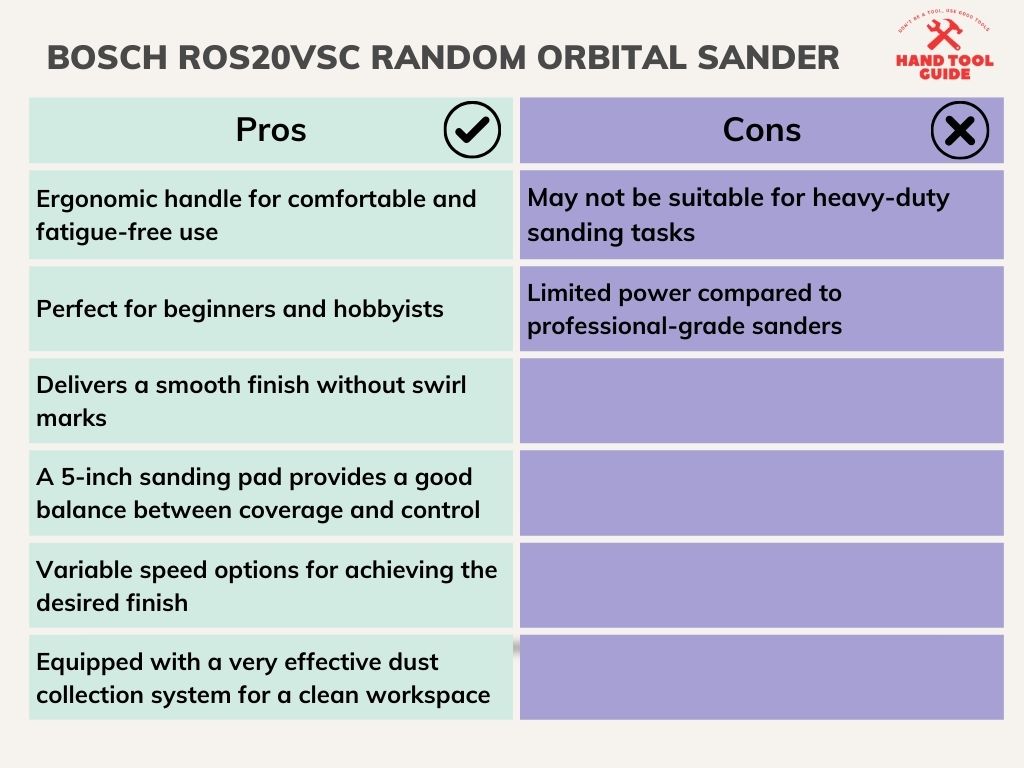
Bosch Orbital Sander ROS20VSC Comparison List
- Bosch 1250DEVS Random Orbital Sander

Bosch 1250DEVS Random Orbital Sander
If you’re looking for a slightly more professional-grade orbital sander, this model is the one for you. With its 6-inch sanding pad, you can quickly cover a larger surface area. It’s a powerful random orbital sander with an impressive motor (6.5 amp) and variable speed options.
This makes it ideal for heavier-duty sanding tasks. This sander also features a dust collection system and easy-to-change sanding discs, ensuring a clean and efficient sanding experience. While it may be pricier than other options, its durability and performance make it a worthwhile investment for professional woodworkers. You only need to look at the reviews on Amazon for this corded random orbital 6-inch sander to be convinced of its quality. This a beautiful corded tool.
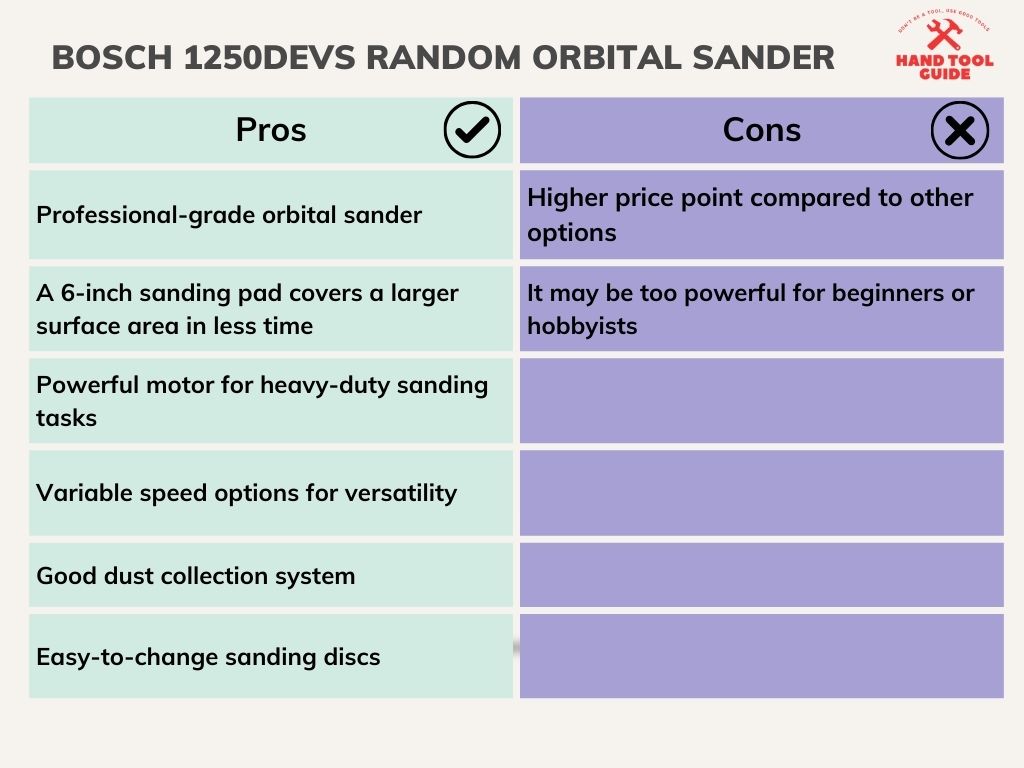
Bosch 1250DEVS Random Orbital Sander Pros and cons
- Makita XOB01Z 18V LXT Lithium-Ion Cordless Random Orbit Sander

Makita XOB01Z 18V LXT Lithium-Ion Cordless Random Orbit Sander
This cordless orbital sander strikes the perfect balance between exceptional power and affordability. Its 5-inch sanding pad is suitable for most sanding projects, and its variable speed control allows you to adjust the sanding speed to suit your needs. Its lightweight design and ergonomic handle offer comfortable handling and maneuverability. It also includes a dust collection system with a dust collection bag, keeping your work area clean and reducing the risk of respiratory issues.
This cordless orbital sander is a reliable choice for beginners and experienced DIYers. The battery will last 40 minutes on the lower speed and about 20 minutes on the high speed. It has a tremendous orbital action, which delivers a scratch-free finish with minimal experience needed.
The Makita random orbital sander is an exceptional little tool that shows just how far battery technology has come of late. Using this 5-inch sander made us wonder why they still make corded sanders. The sander is lightweight for a battery tool. It is the perfect sander.
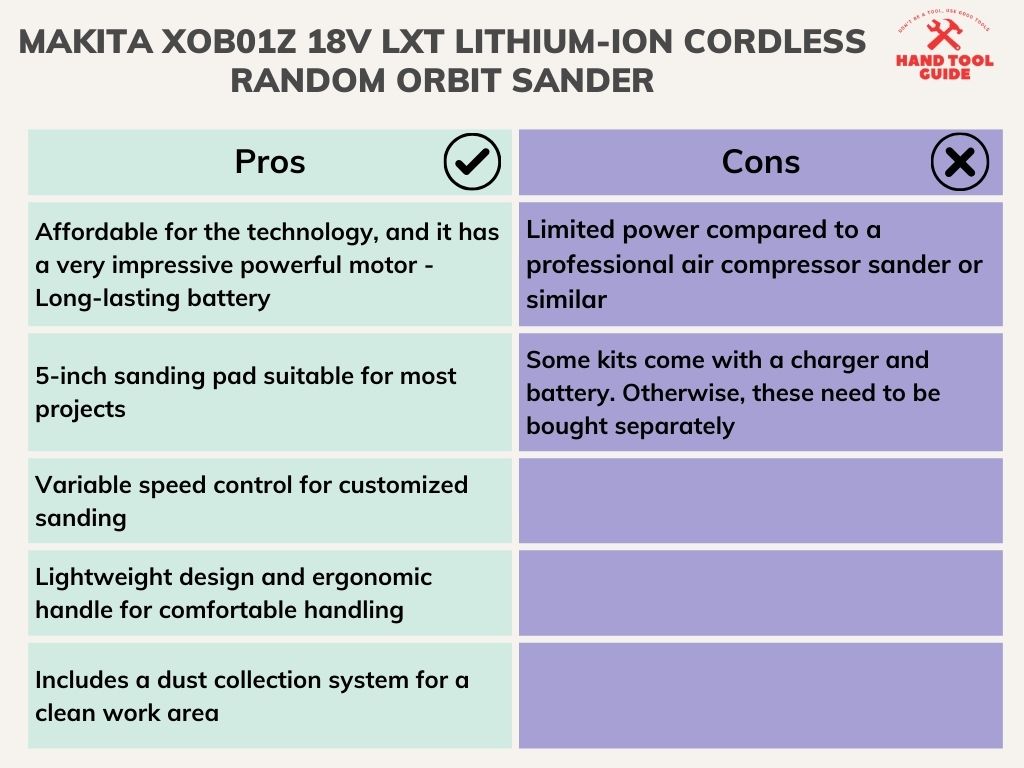
Makita XOB01Z 18V LXT Lithium-Ion Cordless Random Orbit Sander
- Air Random Orbital Sander, 5″6″ Vacuum Pneumatic Air Sander
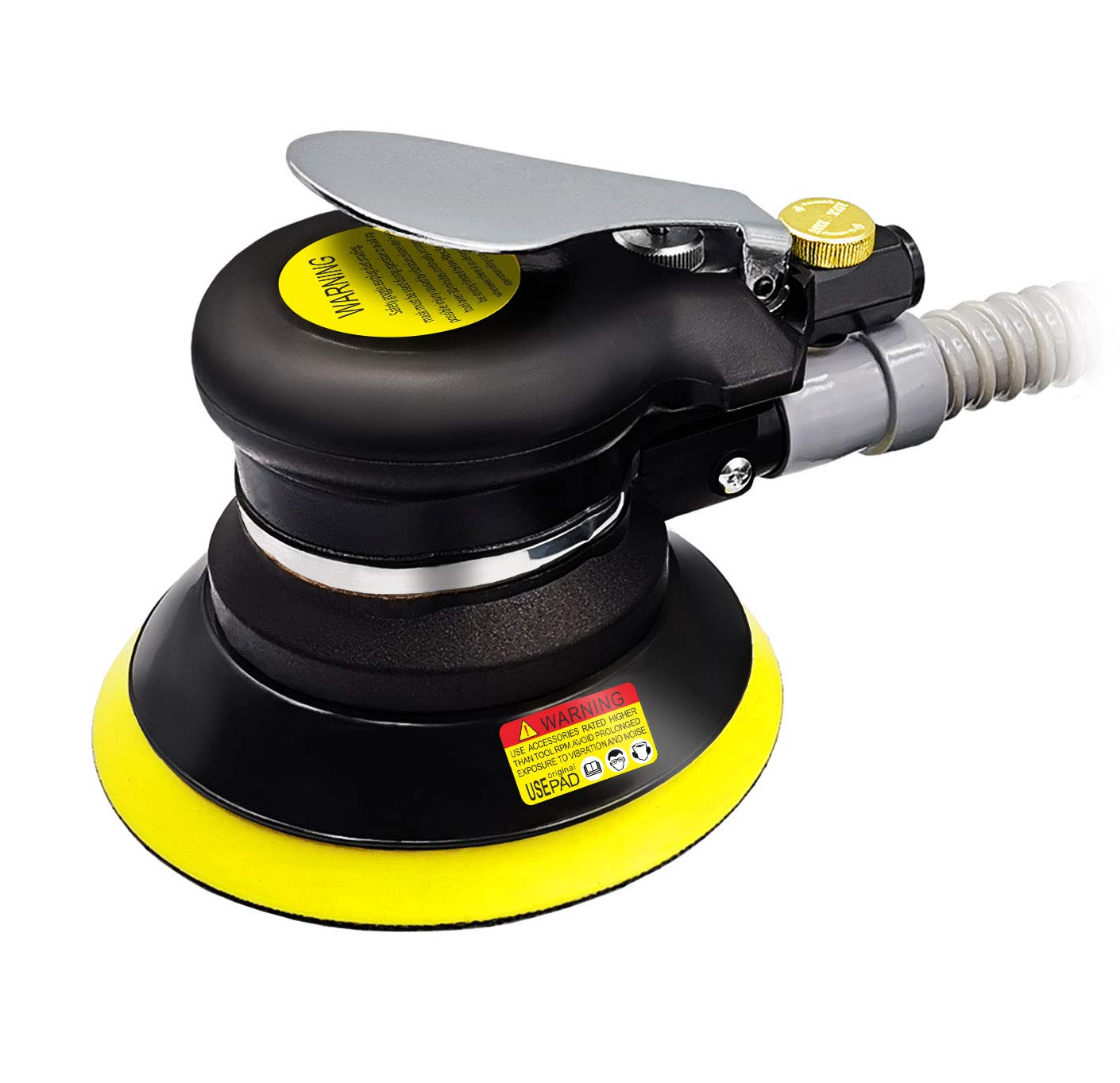
Air Random Orbital Sander
This model is a top-notch option for those who prefer air-powered orbital sanders. Its pneumatic design offers exceptional power and durability, making it the go-to choice for professional woodworkers. With its 5 or 6-inch sanding pad and variable speed options (up to 10,000 RPM), it can handle even the most demanding sanding tasks with ease. While it may require additional equipment, such as an air compressor, the performance and longevity of this sander are unparalleled.
The beauty of pneumatic sanders is that they can polish and sand wood, metal, walls, glass fiber, and other surfaces. A polishing sponge opens the tool up to polishing and sanding furniture and even wax polishing your car. These machines can also be hooked up to the shop vac.
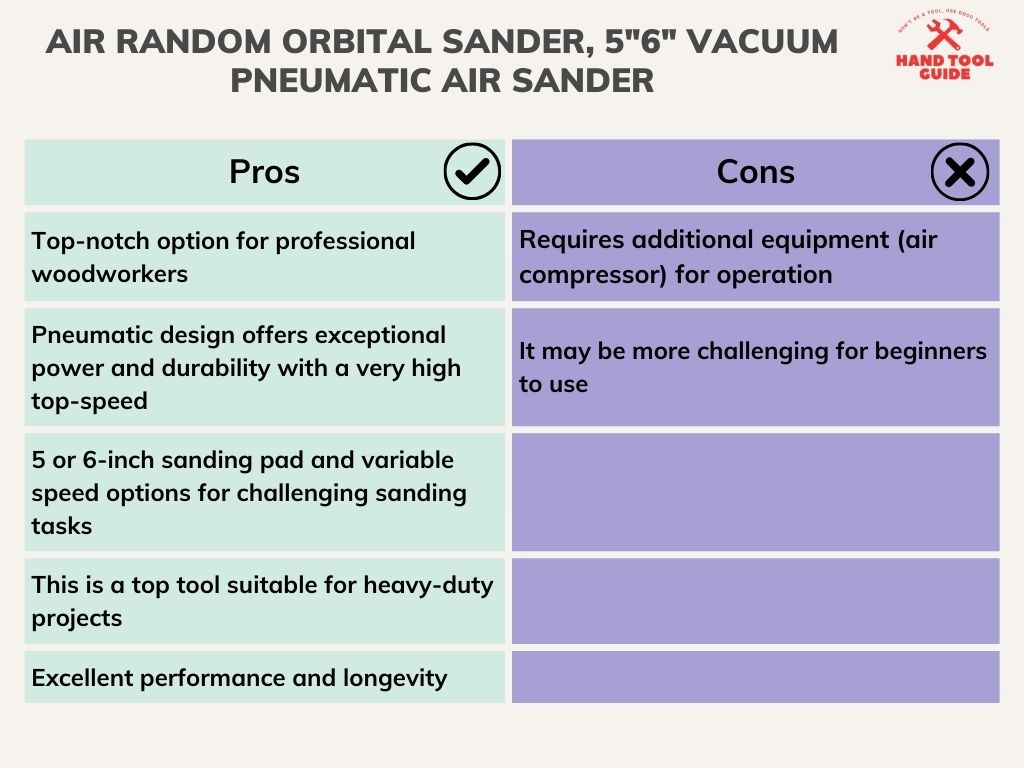
Air Random Orbital Sander, 5″6″ Vacuum Pneumatic Air Sander
- Best Value Sander we Tested, Black+Decker Orbital Sander, 5 Inch
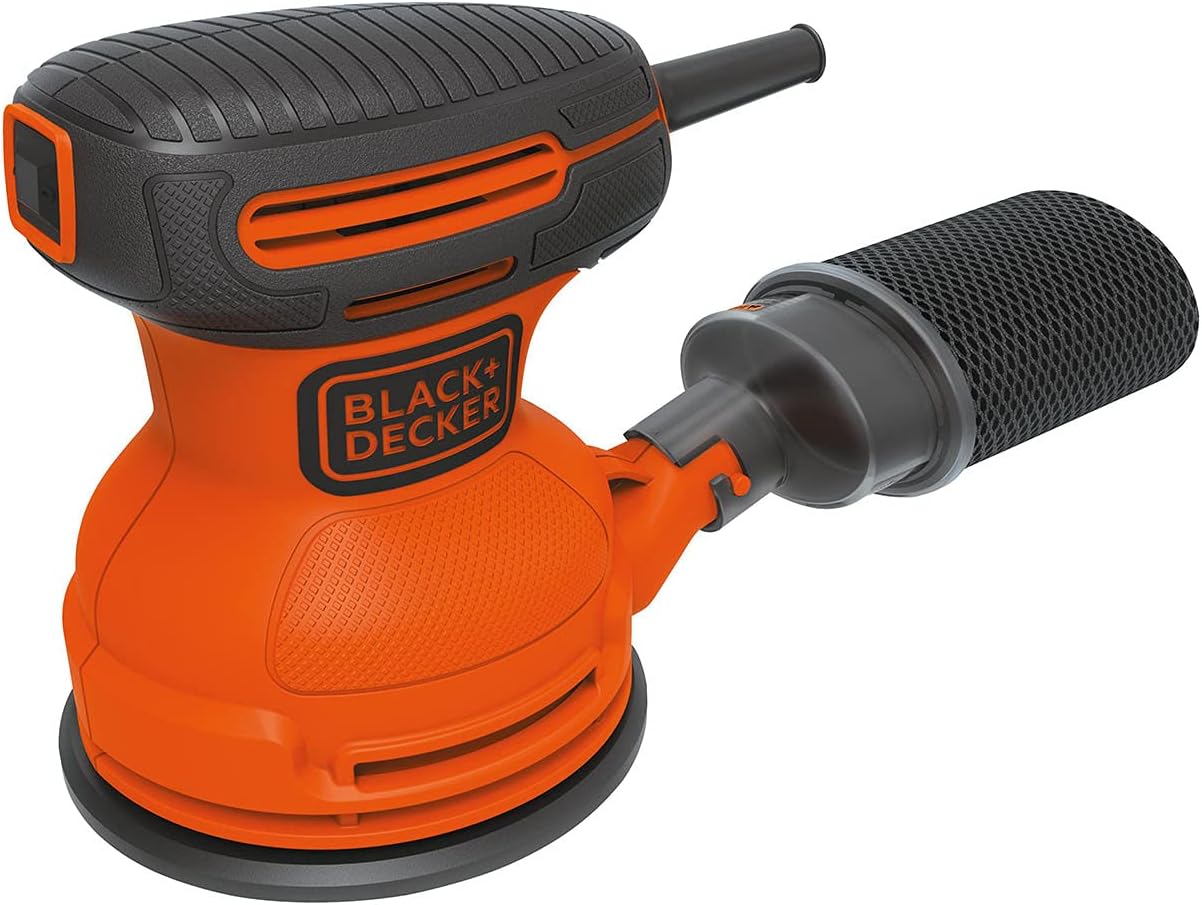
Black + Decker Orbital Sander
Last but not least, this 5-inch sander is a reliable and budget-friendly option. This little sander has excellent reviews on Amazon. Black & Decker generally has a high quality-to-price ratio; this sander is no exception. This was the cheapest sander in the test, but it outshone many other sanders.
It has a 2.4 Amp motor and easily removes paint and other materials at a speed of 12,000 orbits per minute. It left a clean, swirl-free finish on most occasions. It’s not the last word on sanding power, but it has other attributes, such as being very silent and light. It is perfect for light sanding tasks and has discs that attach easily. This small sander is going to be used in many home improvement tasks. We thoroughly enjoyed using the sander and used it with a grit of 120 max.
In the value section, we also liked the DeWalt DWE6423K. This is another lovely and light new generation of palm sanders and one of the better corded models out there.
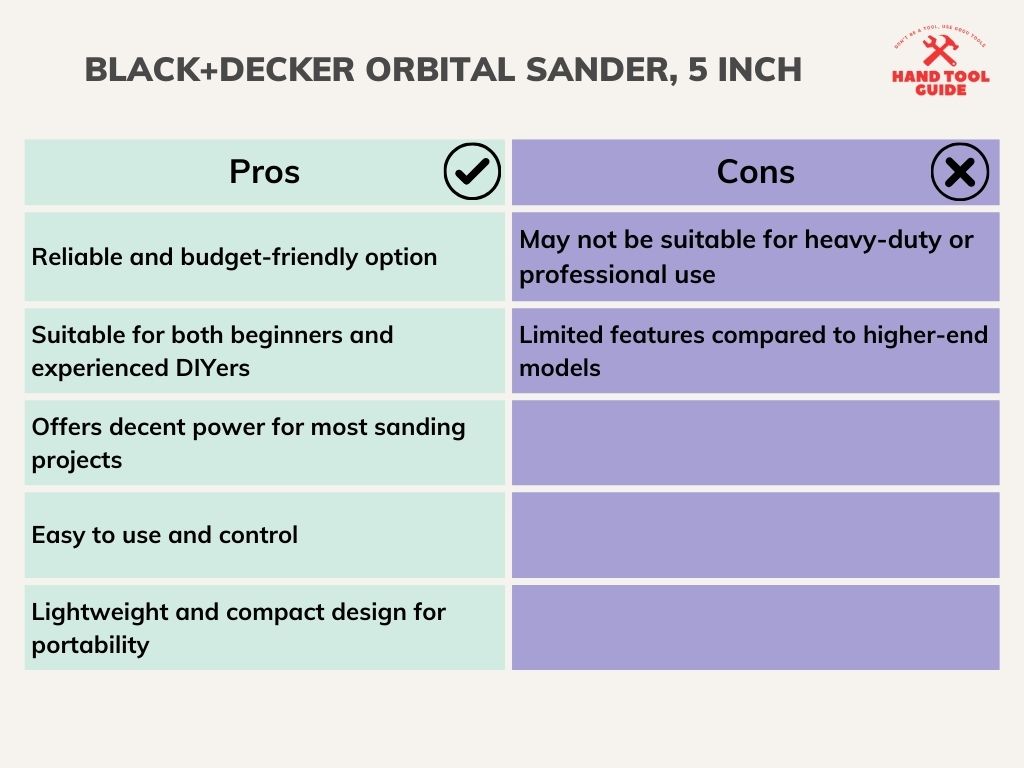
Black+Decker Orbital Sander, 5 Inch Comparison Table List
Using Random Orbital Sanders
When using different random orbital sanders, you quickly determine that each tool has unique strengths and weaknesses. Look at the pros and cons of each sander and take into account your sanding needs. Whether you’re a beginner, hobbyist, or professional woodworker, there is the right orbital sander for you.
When choosing a suitable orbital sander (that is best for your needs), it’s essential to consider a few key factors. Taking these factors into account will ensure that you’re investing in the best orbital sander to help you achieve professional-level results.
First and foremost, consider the type of projects you’ll be working on. If you’re a beginner or hobbyist who primarily works on small woodworking projects, a smaller orbital sander with a 5-inch sanding pad may be the perfect choice. It will balance coverage and control well, allowing you to sand intricate or curved surfaces easily.
On the other hand, if you’re a professional woodworker who often tackles large projects, opting for a 6-inch sanding pad will allow you to cover a larger surface area in less time. This can be especially beneficial when working on tabletops, cabinets, or large pieces of furniture.
What types of wood will you primarily be working on? Will you be sanding corners, curves and difficult to reach areas?
Features Such as Best Dust Collection are Important
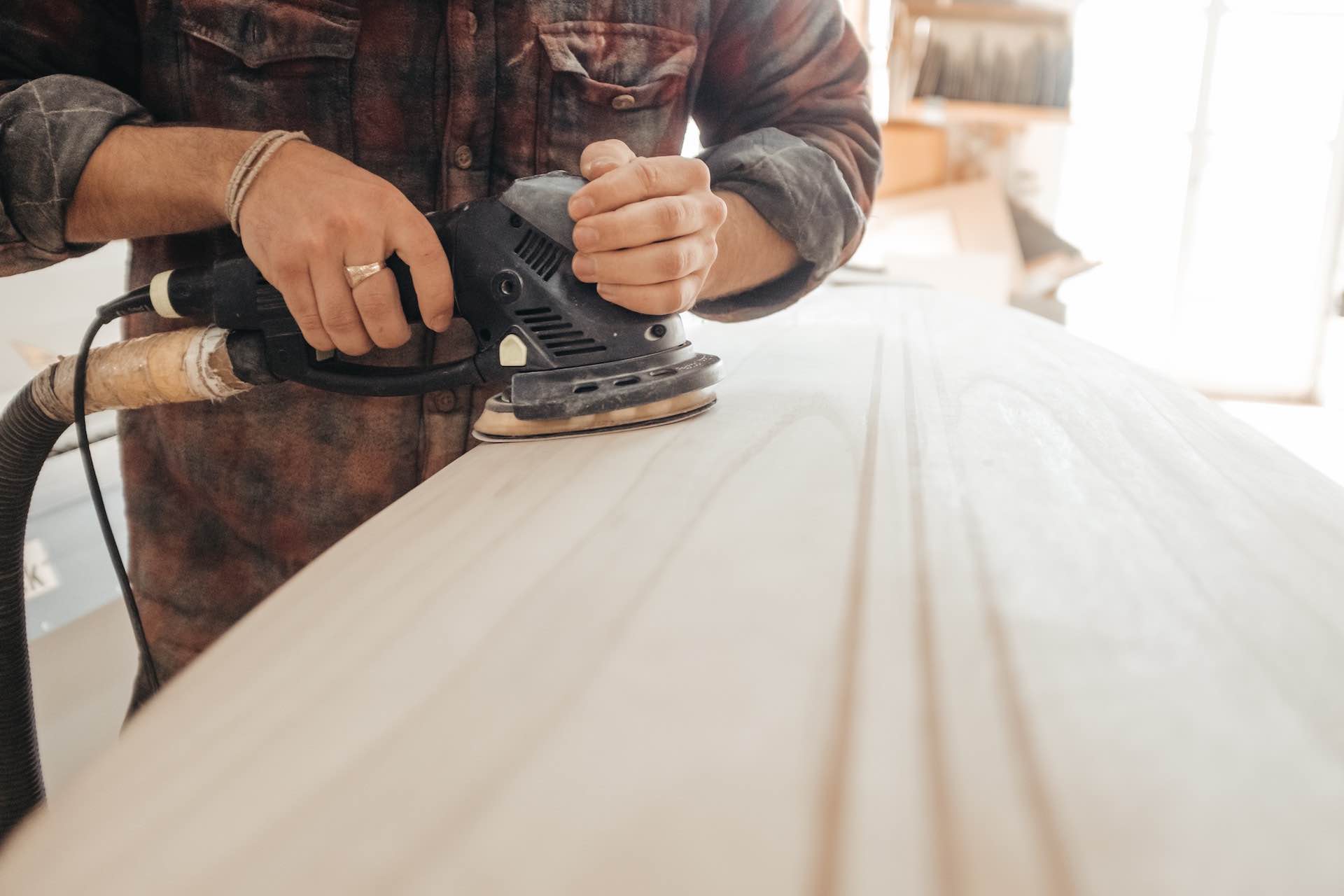
Only when you test sanders do you pick up essential differences like dust collection. Even though you will wear a dust mask when sanding, and almost every sander has some dust pick-up, they vary in efficiency here.
Orbital sanding is messy. You want a tool with as little mess as possible. You also don’t want an overly aggressive sander from both a mess and finish point of view.
Consider the power and speed options of the orbital sander. A variable speed control is a very valuable feature that allows you to adjust the sanding speed based on the material and desired finish. This is particularly important when working on delicate or softwood surfaces that require a gentler touch.
Additionally, more powerful sanders are better suited for heavy-duty sanding tasks and can quickly remove material. If you often work with hardwood or need aggressive sanding, opting for a more powerful sander will be wise.
Conclusion

The best orbital sander for me
Another important consideration is the type of orbital sander you prefer. Electrical orbital sanders are more common and accessible to most individuals. They are also generally more affordable. Electrical orbital sanders also only require a standard electrical outlet. However, if you’re a professional woodworker looking for the best, investing in an air-powered orbital sander may be worth considering.
Although they require an air compressor to function, they offer exceptional power and durability, making them the preferred choice for professionals who regularly tackle heavy-duty sanding tasks.
For most DIYers, corded random orbital sanders are probably not worth the saving over a good cordless device.
Finally, additional features that enhance user comfort and convenience should be considered. Look for an orbital sander with an ergonomic handle that is comfortable for you. This will help keep you fatigue-free, especially if you anticipate long sanding sessions. A dust collection system is another valuable feature, as it keeps your workspace clean and reduces the amount of airborne particles, improving the overall safety and quality of your work.
Lastly, look for sanders with easy-to-change sanding discs, saving you time and frustration during sandpaper replacements.
Good hunting.
